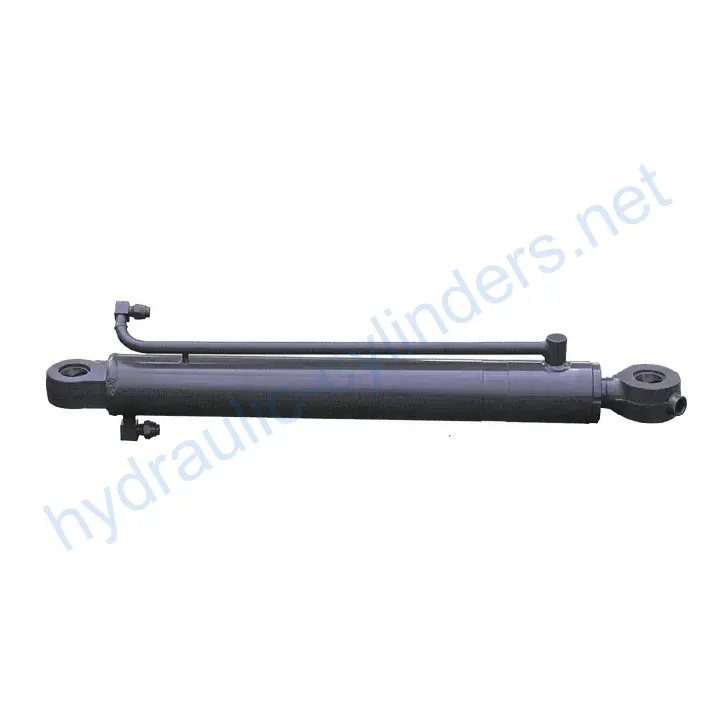Bucket Cylinder For JCHI NS09-7
As one of the hydraulic cylinders manufacturers, suppliers, and exporters of mechanical products, We offer hydraulic cylinders and many other products.
Please get in touch with us for details.
Mail:sales@hydraulic-cylinders.net
Manufacturer supplier exporter of hydraulic cylinders.
Bucket Cylinder For JCHI NS09-7
Introduction
A bucket cylinder is a type of hydraulic cylinder designed specifically to control the movement of buckets in heavy machinery such as excavators, backhoe excavators, and front-end loaders. Its main function is to enable the bucket to lift, lower, and tilt, making it easier to handle a variety of materials. In hydraulic systems, the bucket cylinder uses changes in hydraulic oil pressure to precisely control the bucket, allowing operators to efficiently handle heavy objects and adapt to complex work environments and diverse job requirements.

Features
- High Strength and Durability: Typically made of high-strength steel or aluminum, it can withstand high pressure and heavy loads, adapting to harsh work environments. The design also takes into account wear resistance and corrosion resistance, extending its service life.
- Efficient Hydraulic Operation: Smooth extension and retraction movement achieved by utilizing hydraulic oil pressure, can respond to control commands quickly, provide powerful pushing and pulling force, suitable for handling heavy objects and complex tasks.
- Various Types: Users can choose a single-acting (hydraulic in one direction only) or double-acting (hydraulic in both directions) cylinder according to their needs to meet different operational requirements. Some models are telescopic, allowing for greater extension without increasing external dimensions, suitable for limited space applications.
- Product Replacement: Our product can perfectly replace these hydraulic cylinders.

Applications
Bucket cylinders are widely used in various fields such as construction equipment, agricultural machinery, excavators, and loaders.
- Construction Equipment: In excavators, they are essential for digging, loading, and moving soil or debris. In backhoe excavators, the bucket cylinder helps with both digging and lifting. In loaders, they assist in lifting and dumping goods effectively.
- Agricultural Machinery: Used in front-end loaders for scooping, lifting, and transporting soil, hay, and other materials.
- Excavators: The bucket cylinder achieves digging action by allowing the bucket to penetrate the soil.
- Loaders: In front-end loaders, they assist in lifting and tilting cargo efficiently.
Design Considerations and Selection Criteria
When designing bucket cylinders, key factors such as load-bearing capacity, sealing, durability, safety, and maintainability are taken into account.
- Load-Bearing Capacity: The cylinder must be able to withstand high pressure and heavy loads in harsh environments.
- Sealing: Various sealing elements such as piston seals and rod seals are made of wear-resistant materials such as polyurethane and nitrile rubber to ensure high sealing performance.
- Durability: The cylinder body and threaded ends are finely processed to increase wear resistance, ensuring long service life.
- Safety: Various safety measures such as the use of safety valves and pressure relief valves are taken to ensure safe operation of the cylinder.
- Maintainability: The cylinder is easy to maintain and repair, with components such as seals and bearings easy to replace.

Sealing and Lubrication
The bucket cylinder uses various sealing elements such as piston seals and rod seals to prevent hydraulic fluid from leaking. The cylinder body and threaded ends are finely processed to increase wear resistance. Regular lubrication is required to ensure smooth operation of the cylinder.
Maintenance and Repair
Regular inspection and preventive maintenance measures such as lubrication, seal replacement, and calibration checks are essential to extend the service life of the bucket cylinder. Proper installation and alignment of the cylinder are crucial for safe and efficient operation.
- Regular Inspection: Regularly inspect the cylinder for signs of wear, damage, or leaks.
- Proper Lubrication: Use appropriate lubricants to ensure smooth operation of the cylinder.
- Seal Replacement: Replace worn or damaged seals to prevent hydraulic fluid from leaking.

Safety and Environmental Considerations
Safety measures such as the use of safety valves are taken to ensure the safe and efficient operation of the bucket cylinder. Additionally, environmental protection measures such as proper disposal of hydraulic fluid are taken to minimize environmental impact.
Troubleshooting and Common Problems
Common problems with bucket cylinders include leaks, insufficient force, and slow operation. These issues can be resolved by checking for damaged or worn seals, checking the hydraulic fluid level, and ensuring proper alignment of the cylinder.
About Us
We are a manufacturer of hydraulic cylinders that can replace traditional hydraulic cylinders. We have a wide range of products and are one of the leading manufacturers and wholesale distributors of hydraulic cylinders in the domestic and foreign markets. We adhere to the strategy of industrial production management based on excellent quality and rely on the application of technical talents, digital high-end manufacturing equipment, and professional testing systems to continuously improve our manufacturing platform and product quality production line, and have strong creative ability to meet customer diverse needs with high efficiency, high precision, and high-quality principles.
We offer professional, international certified, customized services, high-end production equipment, and aftersales service, among other attributes.

Author: lyl
Take a Tour of Our VR Factory:
Take a tour of our VR factory with the following
Hydraulic Cylinder Application:


